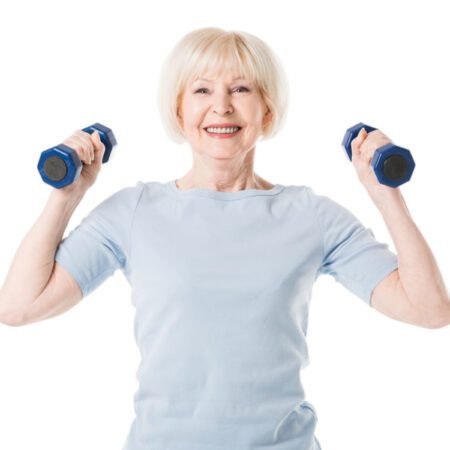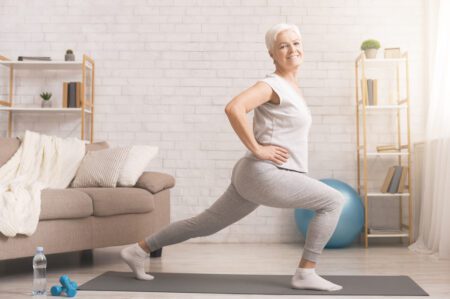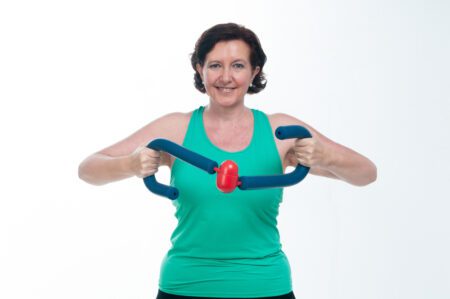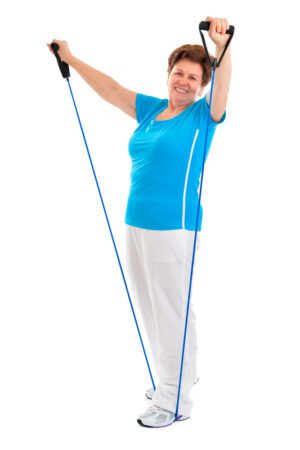 The benefits of strength training for seniors are often overlooked in favor of cardio exercises such as walking.
The benefits of strength training for seniors are often overlooked in favor of cardio exercises such as walking.
However, strength training (also known as resistance or weight training) suits people of any age who want to improve their muscle tone and physical strength. And the potential benefits go well beyond that!
As we age, our metabolism slows, and our muscles lose mass and strength. This is known as sarcopenia.
The amount of muscle lost varies depending on several factors, including genetics, diet, lifestyle, and physical activity level.
Strength training exercises help preserve existing muscle mass and can create more. And being weight-bearing, it builds stronger bones.
This combination of benefits can reduce the risk of age-related problems such as falls and osteoporosis.
Keep reading to learn more about how strength training can help you stay healthy, active, and independent, whatever your age.
If you’re having trouble starting, you may like to read How to Start Exercising Again or for the First Time, and Stick with It.
Table of Contents
But won’t it make me look like a man?
It’s not uncommon for women to worry that weight training will make them look like a man.
The reality is that female hormones are different from those of males, and it takes a specific diet and consistent use of heavy weights to build bulk.
Doing isometric or bodyweight exercises, using fitness bands, a Pilates Circle, or lifting light weights will improve your strength and muscle tone without making you resemble the Incredible Hulk.
Let’s look at some of the benefits of strength training for seniors in more detail, followed by the drawbacks.
Benefits of Strength Training for Seniors
The benefits of strength training for seniors include:
-
Can be low-impact
Not all strength-building exercises are low-impact, but you still have many options.
Low-impact exercises minimize the force on your joints, making them ideal for those recovering from an injury or experiencing age-related physical issues such as arthritis or joint pain.
(Scroll down for a brief overview of the main types of strength training exercises below, most of which are low-impact.)
-
Builds muscle and strength
Seniors, and for that matter, adults of any age, should make strength training a part of their fitness program.
According to research, muscle mass peaks in the third decade of life, declining by approximately 3 to 5% per decade after that. That’s the equivalent of 4 to 6 pounds, with the muscle replaced by fat and fibrous tissue.
This rate varies from person to person, and the older we get, the faster the decline.
Research estimates that between the ages of 60 and 70, we will have lost 12 percent of our muscle mass and 30 percent by age 80.
With weak muscles, you are more susceptible to falls and injury. Regular strength training sessions can counteract this by maintaining and adding muscle.
In addition to age, other factors such as inactivity, poor nutrition, and chronic illnesses can contribute to muscle loss.
Regular exercise, particularly resistance training, can help slow down muscle mass loss and maintain muscle strength as we age.
-
Improves balance and coordination
Stronger muscles typically equate to better balance and coordination.
Seniors with good balance and coordination have better functional fitness, making it easier to perform everyday activities such as grocery shopping, getting out of bed, or climbing stairs without assistance.
It also offers protection from injuries, including falls.
-
Improves flexibility
Regular training sessions will improve your flexibility and range of motion, enabling you to move more smoothly and confidently.
You will be less susceptible to injuries such as muscle strains and may be less prone to experiencing chronic pain.
Furthermore, the more flexible you are, the more efficiently your muscles will perform, so you will get more from your workouts.
-
Promotes good posture
Resistance training exercises can add flexibility and suppleness to your spine, neck, and shoulders, decreasing the risk of back pain and developing the dreaded hunch.
You will also appear more youthful if you have good posture.
-
Improves mobility
Research has shown that the increase in muscular mass and strength, bone density, balance, coordination, flexibility, and range of motion that regular strength training workouts deliver can improve mobility in seniors.
regular strength training workouts deliver can improve mobility in seniors.
This combination of benefits will allow you to move and undertake daily activities more efficiently, lower the incidence of injury, and help prevent falls.
-
Boosts vitality
Regular participation in strength-training programs can increase energy levels.
This is due to a higher production rate of mitochondria, the powerhouse cells responsible for producing energy in your body.
-
Improves physical health
Regular strength training can improve cardiovascular health by reducing blood pressure and cholesterol levels.
Workouts can lower the risk of chronic diseases such as arthritis and Type 11 diabetes.
Additionally, they will increase your metabolism, so you burn more calories, helping you maintain your current weight or lose excess pounds.
-
Improves mental health
The psychological benefits of exercise, including strength training for seniors, are substantial.
Studies show it enhances brain neuroplasty, improving cognitive functioning among older adults.
Simply put, it improves thinking skills such as memory recall, decision-making, and problem-solving, lowering the risk of mental decline and depression.
However, not all forms of strength exercise provide the same degree of mental benefits, with certain types thought to be more advantageous than others.
These include exercises that involve both compound movements and isometric exercises for increased muscular endurance and stability.
Compound movements involve moving multiple joints simultaneously (e.g., Squats).
Isometric exercises involve maintaining technique with a static position (e.g., Planks).
Both types of exercise can be done with or without weights, depending on the individual’s preferences and capabilities.
Exercise, in general, is associated with an increased sense of well-being due to the improved self-image and confidence it can impart and the lower incidence of depression.
-
Lowers the risk of osteoporosis
Studies have shown that seniors who strength train regularly can significantly reduce their risk of osteoporosis.
Osteoporosis is a condition that renders bones porous and brittle, making them more likely to break if you fall. For seniors, a broken bone can have devastating consequences.
As well as decreasing the risk of developing osteoporosis, strength training exercises can increase bone mineral density making bones stronger and less likely to break or fracture.
Along with increased bone density, some studies suggest that sustained resistance exercise contributes to new bone formation, helping keep older adults safer from fractures caused by falls or injuries.
-
Increases confidence
Strength training can boost confidence in seniors, making them feel more comfortable and secure as they move around.
Increased confidence can help seniors maintain their independence and enjoy a higher quality of life.
Drawbacks of Strength Training for Seniors
While strength training can be beneficial for seniors, there are also some potential drawbacks and concerns to consider, including the following:
-
Increased risk of injury
As we age, our bones, joints, and muscles become more vulnerable to injury.
If proper form and technique are not used during strength training, seniors may be at risk of injuring themselves.
-
Overexertion
Older adults may have less stamina and endurance, making recovering from intense strength training sessions harder.
Overexertion can lead to fatigue, muscle soreness, and other complications.
For this reason, it’s essential to take things slowly and not use weights that are too heavy. (See below for weight, exercises, sets, and reps recommendations.)
-
Health conditions
Seniors may have health conditions affecting their ability to engage in strength training, such as arthritis or osteoporosis.
They may need to modify their workouts to accommodate these conditions.
-
Lack of knowledge
Some older folk may need to familiarize themselves with proper strength training techniques and how to use equipment safely.
This is also true for younger people, but recovering from an injury can take longer as we age.
Next, we will look at some of the most popular types of strength training exercises and what they entail.
The Benefits of Strength Training for Seniors
A Brief Overview of the Main Types of Strength Training Exercises
Strength training exercises that can be beneficial for seniors include the following:
Isometric Exercises –
Isometric exercises involve holding a static position while placing tension on various parts of the body, such as the arms, shoulders, hips, etc.
Strengthening isolated muscle groups during a limited range of motion is ideal for seniors who wish to stay physically active while avoiding strain on joints and ligaments.
Bodyweight Exercises –
Bodyweight exercises are perfect for seniors who do not have access to equipment or want a more straightforward approach than weight lifting.
lifting.
Push-Ups, Lunges, Squats, and Planks are all excellent examples of bodyweight exercises that stimulate muscle development in areas like the chest, arms, legs, and core.
Fitness Bands –
Fitness bands, also known as resistance bands, are elastic bands that provide resistance when stretched.
They can be used to perform various low-impact strength-building exercises such as Bicep Curls, Tricep Extensions, Leg Presses, and Chest Presses. They also improve flexibility and range of motion.
You can adjust the resistance level to suit your strength and fitness goals.
Pilates Circle –
Pilates circles, also known as magic circles, are small, circular rings made of metal or rubber used to perform exercises to strengthen and tone the muscles of the arms, legs, and core.
Exercises are typically done in a slow and controlled manner, which can help improve balance, flexibility, and coordination.
Weight Lifting –
Weight lifting involves using weights (kettlebells, barbells, dumbbells, a home gym machine, etc.) to build muscle and strength.
Some exercises involving these fitness aids are high-impact, but there are plenty of low-impact ones too.
I bought my mom these dumbbells made by Crown Sporting Goods, which she loves.
They are compact, so they only take up a little space, are comfortable to grip, and don’t get slippery if your hands’ sweat.
The weights come in a set comprising a pair of 1 lb, 2 lb, and 3 lb weights, along with a stand for storing them.
The 1 lb weight is pink, the 2 lb green, and the 3 lb blue, each numbered in large font.
You’ll have to assemble the stand, which takes a few minutes. It’s just a matter of inserting six screws, for which you will need a Phillips crosshead screwdriver.
If you already have some upper body strength or are a senior male new to weight lifting, I recommend this set from Signature Fitness, which comes with a pair of 3 lb, 5 lb, and 8 lb weights.
You may like to check out these bone-stregthening exercises using weights.
Other options
If you don’t want to do any of the exercises above, try Yoga, Pilates, or Barre. Swimming or pool noodle exercises are other excellent options if you have pool access.
All are low-impact and can strengthen and tone your entire body when done regularly.
NB: For safety’s sake, don’t swim or do pool noodle exercises alone.
Weight, Exercises, Reps, and Sets Recommendations
When using free weights, choose one – or a pair – light enough to maintain the correct form and heavy enough that the last few reps are challenging.
A weight of between 1 and 3 lbs is a good starting point, though some people will be able to go heavier.
Choose between 6 and 10 exercises, making sure they target different muscle groups.
Do 12 to 15 repetitions of low-impact exercises such as Triceps Kickbacks, Bicep curls, and Shoulder Presses, and 8 to 10 reps for high-impact exercises like Squats, Lunges, and Deadlifts.
Start with one or two sets, building to 3 or 4 over time if desired, resting 30 to 45 seconds between each.
Perform each repetition slowly and correctly. By focusing on using the proper form rather than how much weight you can lift, your injury risk will decrease substantially.
Work out two or three days per week, taking a day off between workouts to allow your muscles to rest and repair.
Listen to your body, and don’t push yourself beyond your limits.
Use a lighter weight If you can’t maintain the proper form for the entire set.
Key Safety Considerations
With any exercise comes the risk of injury. The following tips will keep you as safe as possible while undertaking strength toning exercises.
Consult with your healthcare provider –
Before you start, please consult with your healthcare provider or a personal trainer specializing in seniors’ fitness to make sure it’s safe for you to engage in physical activity.
This is particularly important if you have been very sedentary for a long time or have a medical condition that could preclude you from exercising.
Ease into it –
If you’re new to strength training and very out of shape, start with isometric or bodyweight exercises, in which case you won’t need any equipment.
Don’t overdo it. You can always increase the weight or resistance later when you are stronger and fitter.
Include a variety of exercises –
Incorporate exercises that target different muscle groups to prevent boredom, avoid over-use injuries, and ensure balanced strength and muscle development.
Warm-up and cool-down –
To help prevent muscle strain, warm up with some light cardio and dynamic stretching before starting your strength training routine.
This will help prevent injuries by loosening up your muscles, making them more pliable.
After your workout, cool down with static stretches.
Hydrate –
Keep yourself well-hydrated while working out. Dehydration can lead to fatigue, dizziness, injuries, or even heat stroke.
Consider working with a personal trainer –
Working with a personal trainer specializing in senior fitness can be a great way to start.
A trainer will teach you the proper form and technique to avoid injury.
They will also recommend which exercises you should do, including the weight to use and how many repetitions.
Look for a trainer who will come to you if you aren’t comfortable going to a gym. Just make sure they are certified.
After they show you the basics, you can work out at home, progressing at your own pace.
If you don’t want to hire a trainer, many articles and YouTube videos are available for reference.
Some fitness centers offer free workout advice, so if there’s a gym near you, call in and ask.
Final Thoughts on the Benefits of Strength Training for Seniors
Strength training workouts can be a powerful tool for improving many aspects of seniors’ lives. 
They help maintain muscle mass and bone density, improve muscle tone, endurance, balance, coordination, and flexibility, make you stronger, reduce your risk of falls, and improve overall physical and mental health.
By participating in strength training, seniors can also benefit from improved mobility, increased confidence and independence, enhanced quality of life, and chronic disease prevention.
However, approach it with caution.
Consider any potential limitations or risks, and consult with a healthcare professional before starting any new exercise program.
Discuss any medications you take that may affect your ability to exercise safely.
With medical guidance and professional assistance, if needed, for seniors, strength training can be a safe and effective means of slowing or reversing an age-related physical decline.
Give it a try!

